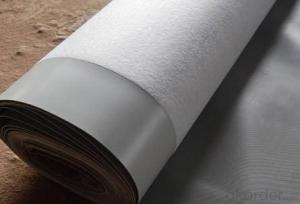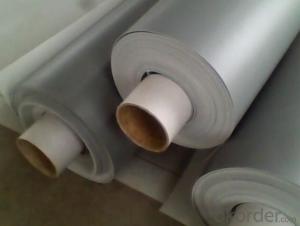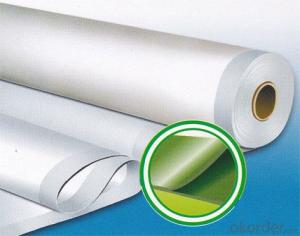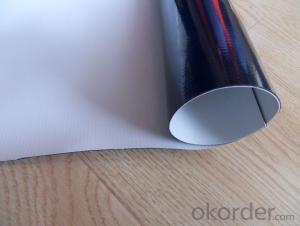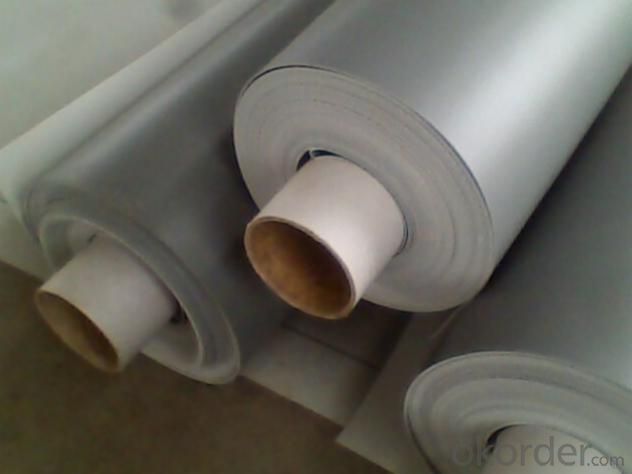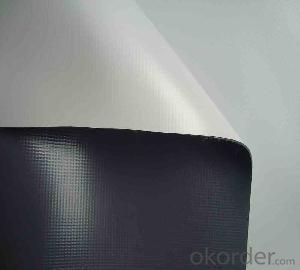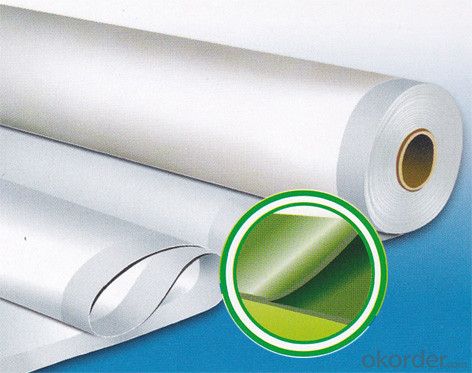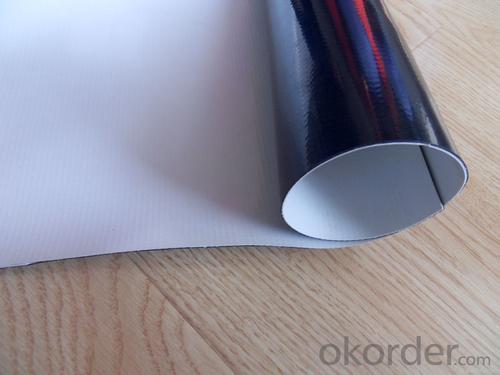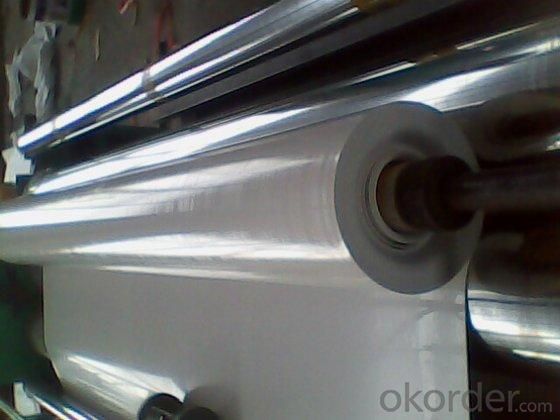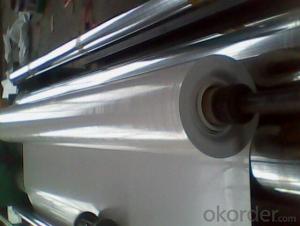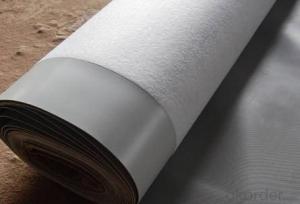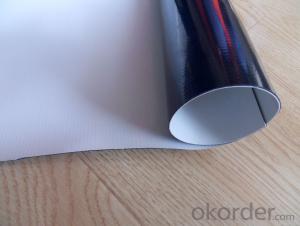PVC Waterproofing Sheet with Fleeced Back in Grey Color
- Loading Port:
- Shanghai
- Payment Terms:
- TT OR LC
- Min Order Qty:
- 20000 m²
- Supply Capability:
- 5000000 m²/month
OKorder Service Pledge
OKorder Financial Service
You Might Also Like
PVC Waterproofing Sheet with Fleeced Back in Grey Color
Product Description of PVC Waterproofing Sheet with Fleeced Back in Grey Color:
PVC Membrane Waterproof /Waterproofing membrane For Roof is a new polymer waterproof membrane. The PVC Membrane Waterproof /Waterproofing membrane For Roof raw material is polyvinyl chloride resin, mixed with plasticizer, filler, antioxygen, ultraviolet absorber and other auxiliaries.
Thickness: 1.2mm/1.5mm/1.8mm/2.0mm
Width:2050mm
Length:20m( Special specifications can be customized)
Size: 2.05mx20m
Color: white/grey, or any other colors.
Features of PVC Waterproofing Sheet with Fleeced Back in Grey Color:
1. Excellent anti-aging property.
2. Puncture- resistant.
3. Welding construction,
4. High tensile strength, good elongation, good dimensional stability.
5. Good plasticity.
6. It has self-extinguishing from fire property.
7. Materials surface is smooth, fast color, stain resistance.
8. More wide, Wastage become less when being used.
Classification of PVC Waterproofing Sheet with Fleeced Back in Grey Color:
1. N: Homogeneous PVC membrane
2. L: PVC membrane with fabric backing
3. W: Reinforced PVC membrane
Advantage of PVC Waterproofing Sheet with Fleeced Back in Grey Color:
1.) Mixing automation. Apply automatic temperature control automatic time control and automatic feed control.
2.) Extrusion equipment uses twin screw coextrusion. Screw temperature uses computer automatic temperature control system.
3.) Handpiece uses large width didhead extrusion equipment.
4.) Sophisticated three-roller calender equipment. The space between equiment is controlled by automation system.
Technical Data of PVC Waterproofing Sheet with Fleeced Back in Grey Color:
No. | Item | Model Ⅱ | |
1 | Tensile Strength Mpa ≥ | 12.0 | |
2 | Elongation at break% ≥ | 250 | |
3 | Shrinkage rate % ≤ | 2.0 | |
4 | Flexibility at low temperature | No crackle at -25oC | |
5 | Water tightness | Watertight | |
6 | Puncture resistance | Watertight | |
7 | Heat aging treatment | Appearance | Free from bubble, crack, cohesion and void |
Change rate of tensile strength % | +20oC | ||
Change rate of elongation at break | |||
Flexibility at low temperature | No crack at -20oC | ||
8 | Chemical corrosion resistance | Change rate of tensile strength % | +20 |
Change rate of elongation at break | |||
Flexibility at low temperature | No crack at -20oC | ||
9 | Artificial weathering | Change rate of tensile strength % | +20 |
Change rate of elongation at break | |||
Flexibility at low temperature | No crack at -20oC | ||
Application of PVC Waterproofing Sheet with Fleeced Back in Grey Color:
1) All kinds of roofs, such as steel structure roof, planted roof etc.
2) Underground engineering, such as building basement, subways, tunnels, air raid shelter, etc.
3) Other projects like artificial lake, dam, water reservoir, grain storehouse, etc.
Images of PVC Waterproofing Sheet with Fleeced Back in Grey Color:
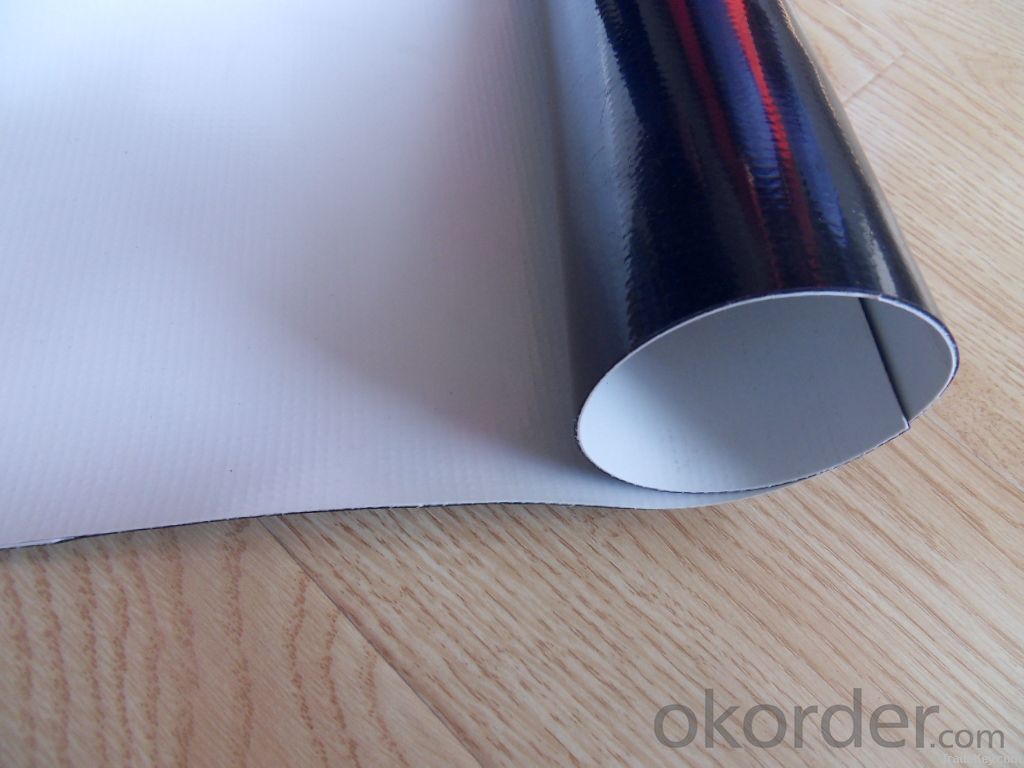
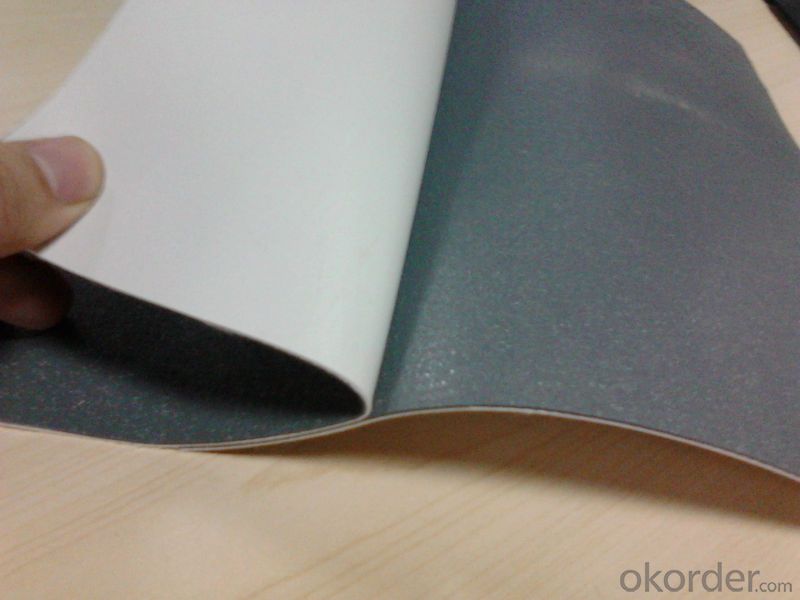
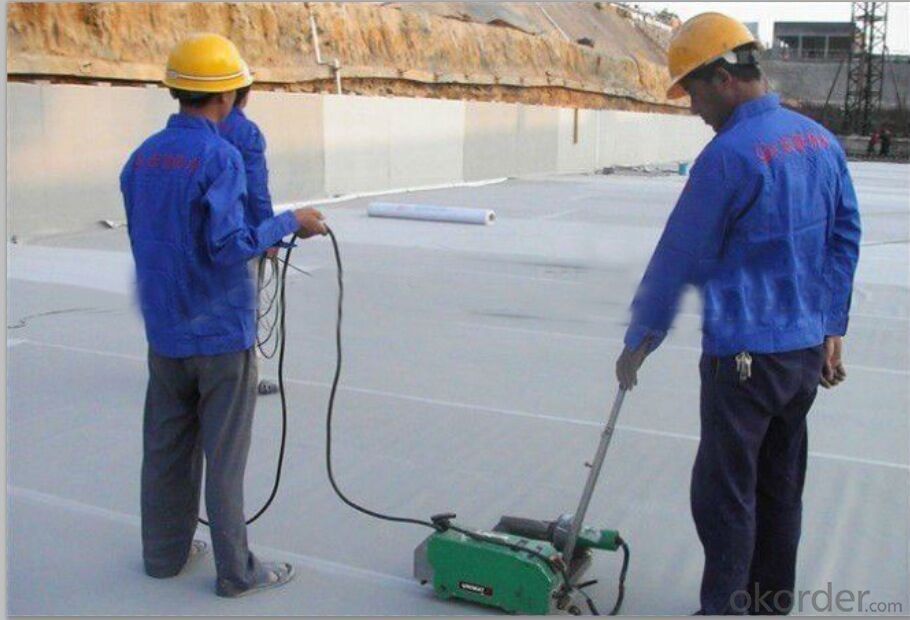
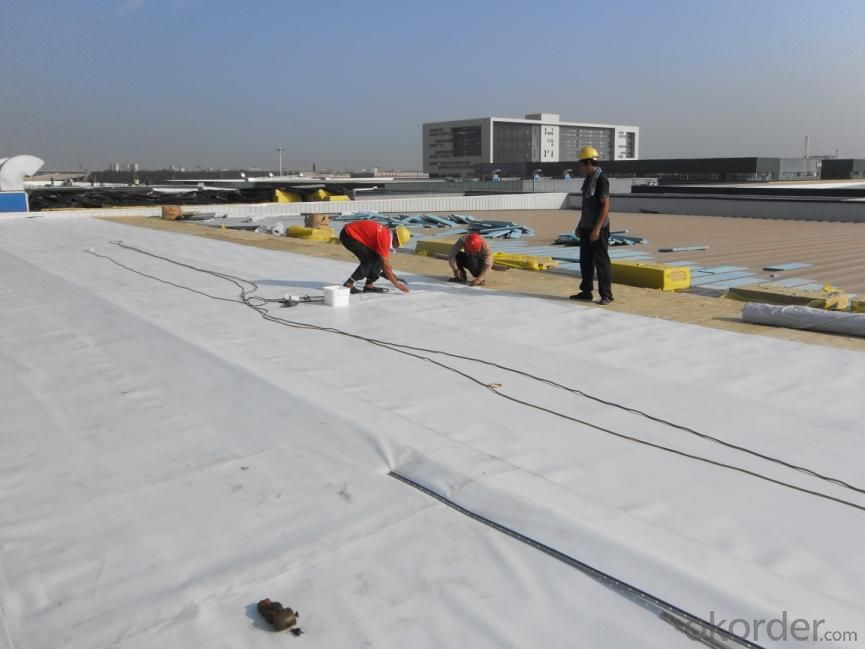
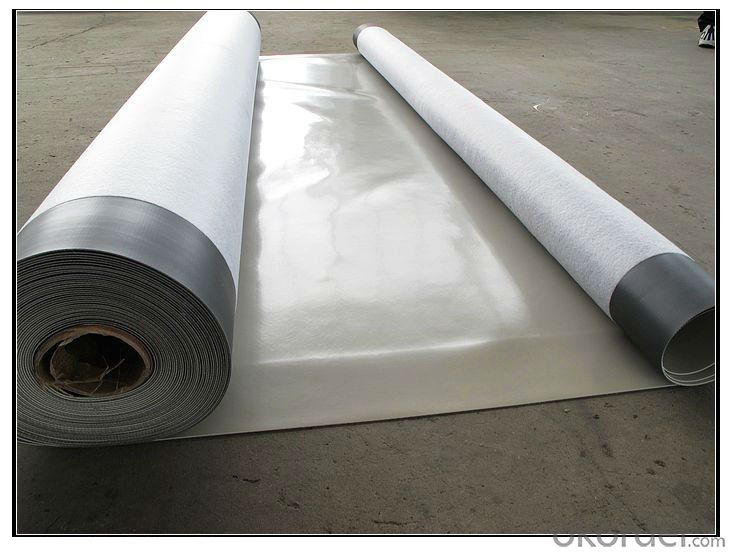
FAQ:
1. Can you produce 4m width?
Yes, no problem for us. We have four bases in China, largest one in this field.
2. How many quantity in one 20'' container for 1.2mm and 1.5mm?
480rolls, 11520m2 for 1.2mm and 400rolls, 9600m2 for 1.5mm
3. Can you provide free samples?
Yes, our samples are free, but express fees usually on buyer's account.
- Q: Why the roof of the waterproof membrane and insulation rock wool board to do between the isolation layer?
- 3, in the insulation layer on whether to protect the isolation layer according to the construction of the insulation layer on the destruction of the role of the waterproof layer. Since the waterproofing membrane has been completed construction, indicating that the flatness has reached a higher demand, and the insulation layer of the grass-roots flatness requirements do not exceed the requirements of the web paving, so waterproof surface without leveling layer, but may need to do protection Isolation layer.
- Q: Can a waterproofing membrane be used on wood block surfaces?
- Certainly! Waterproofing membranes are a suitable option for safeguarding wood block surfaces. The utilization of a waterproofing membrane on wood block surfaces, like decks or wooden floors, can prove advantageous by shielding against water damage and prolonging the wood's lifespan. These membranes function as a barrier, effectively preventing water from infiltrating the wood and causing deterioration, such as rot, warping, or decay, over time. To guarantee optimal outcomes, it is crucial to select a waterproofing membrane explicitly designed for wood surfaces and adhere to the manufacturer's instructions for application. By doing so, the wood block surface can be adequately protected and maintained, ensuring its resilience and longevity.
- Q: On the roof of the waterproofing membrane paving the direction of what are the requirements
- ?For the vibration of the roof, such as the use of parallel roof ridge direction asphalt waterproofing membrane, under the influence of vibration, easy to slip the membrane waterproof layer. And therefore should be vertical roof ridge direction. But the high strength of synthetic polymer film can not be limited.
- Q: Can a waterproofing membrane be used in areas with high foot traffic?
- Yes, a waterproofing membrane can be used in areas with high foot traffic. Waterproofing membranes are designed to provide a protective barrier against water and moisture, making them suitable for various environments, including areas with heavy foot traffic. These membranes are commonly used in commercial buildings, such as shopping malls, hospitals, and office complexes, where foot traffic is frequent. However, it is important to choose the right type of waterproofing membrane that is specifically designed for high foot traffic areas. Some membranes are more durable and resistant to wear and tear, making them ideal for such environments. Additionally, proper installation and maintenance of the membrane are crucial to ensure its longevity and effectiveness in high foot traffic areas. Furthermore, it is worth considering the specific requirements of the area and consulting with professionals or manufacturers to determine the most suitable waterproofing membrane for the given conditions. Overall, with the right selection and proper installation, a waterproofing membrane can effectively protect areas with high foot traffic from water damage and ensure their longevity.
- Q: Are waterproofing membranes resistant to thermal cycling?
- Waterproofing membranes typically exhibit resistance to thermal cycling. Their design allows them to endure temperature variations without compromising their efficacy. Thermal cycling pertains to the repetitive expansion and contraction of materials caused by temperature fluctuations. These membranes are constructed to possess exceptional dimensional stability, enabling them to expand and contract with minimal distortion. By withstanding thermal cycling, these membranes retain their integrity and effectively prevent water infiltration, even in harsh temperature conditions. Nonetheless, it is crucial to acknowledge that the degree of resistance to thermal cycling may differ based on the specific type and quality of the waterproofing membrane employed.
- Q: How does a waterproofing membrane prevent water penetration?
- Waterproofing membranes act as a physical barrier, preventing water from entering the surface they are applied to. They are typically made of impermeable materials like synthetic polymers or bitumen. When properly applied, the membrane adheres tightly to the surface, forming a seamless layer that stops water seepage. Apart from water resistance, these membranes are designed to withstand various environmental conditions and resist damage caused by water pressure, temperature changes, and UV radiation. They are flexible and can accommodate structural movements without compromising their integrity. This flexibility ensures the membrane remains undamaged, preventing any gaps or cracks that water could exploit. Moreover, waterproofing membranes often incorporate additives or technologies that enhance their water resistance properties. These may include hydrophobic compounds that repel water or self-sealing capabilities, allowing the membrane to repair itself if punctured or damaged. In conclusion, a waterproofing membrane creates a durable, impermeable, and continuous barrier that resists water pressure, environmental factors, and structural movements. This barrier keeps the underlying surface dry and protected from potential water damage.
- Q: Can a waterproofing membrane be used for water fountains or decorative features?
- Yes, a waterproofing membrane can be used for water fountains or decorative features. Waterproofing membranes are designed to provide a protective barrier against water penetration and can be applied to various surfaces, including those used in water fountains and decorative features. These membranes are typically made from materials such as rubber, bitumen, or liquid-applied coatings, which offer excellent waterproofing properties. By applying a waterproofing membrane, you can ensure that water does not seep into the underlying structure and cause damage. This is particularly important for water fountains and decorative features as they involve constant exposure to water. Additionally, waterproofing membranes can also help prevent leaks, cracks, and other potential issues that may arise from water exposure, thus prolonging the lifespan of the fountain or decorative feature.
- Q: Can a waterproofing membrane be used in conjunction with soundproofing materials?
- Yes, a waterproofing membrane can be used in conjunction with soundproofing materials. While the primary function of a waterproofing membrane is to prevent water infiltration, it can also contribute to sound insulation to some extent. However, for optimal soundproofing, it is recommended to use dedicated soundproofing materials such as acoustic insulation or soundproof panels in addition to the waterproofing membrane.
- Q: Can a waterproofing membrane be used for a deck?
- Certainly! A deck can indeed benefit from the utilization of a waterproofing membrane. These membranes are frequently employed to shield surfaces from water-related harm by forming a barrier that hinders water infiltration. In the case of a deck, the application of a waterproofing membrane can effectively impede water seepage into the underlying structure, thereby averting issues like decay, distortion, and other types of damage. It is imperative to select a waterproofing membrane specifically crafted for outdoor usage, capable of enduring various elements such as UV rays, temperature fluctuations, and considerable foot traffic. Furthermore, the proper installation and maintenance of the waterproofing membrane on the deck play a pivotal role in ensuring its efficacy and prolonged lifespan.
- Q: How long does it take for a waterproofing membrane to cure or dry?
- The time it takes for a waterproofing membrane to cure or dry can vary depending on various factors such as the specific product used, environmental conditions, and application method. However, on average, it usually takes around 24 to 48 hours for a waterproofing membrane to fully cure and dry. It is important to follow the manufacturer's instructions and allow sufficient time for the membrane to properly cure before subjecting it to water or other elements.
Send your message to us
PVC Waterproofing Sheet with Fleeced Back in Grey Color
- Loading Port:
- Shanghai
- Payment Terms:
- TT OR LC
- Min Order Qty:
- 20000 m²
- Supply Capability:
- 5000000 m²/month
OKorder Service Pledge
OKorder Financial Service
Similar products
Hot products
Hot Searches
Related keywords
